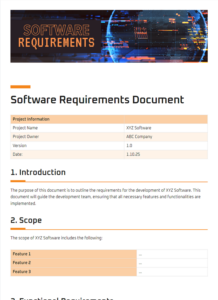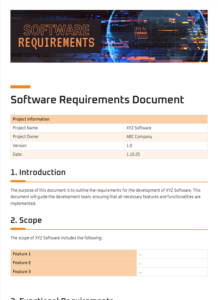Web development projects require a comprehensive set of requirements to ensure the project’s success. A well-defined requirements template serves as a guiding document that outlines the project’s goals, objectives, and technical specifications. By establishing clear requirements from the outset, you can avoid costly rework and ensure that the final product meets the client’s expectations. A comprehensive web development requirements template should cover all aspects of the project, ranging from functional specifications to user interface design.
An essential part of the requirements gathering process is understanding the client’s vision and objectives for the project. This can involve conducting stakeholder interviews, reviewing existing documentation, and performing user research. Based on this information, you can then develop a detailed requirements document that outlines the project’s scope, timeline, and deliverables. A well-written requirements document will serve as a roadmap for the project team, ensuring that everyone is working towards the same goals.
Key Components of a Web Development Requirements Template
A comprehensive web development requirements template should include the following key components:
- Project overview: This section provides a high-level overview of the project, including its purpose, target audience, and key stakeholders.
- Functional specifications: This section outlines the specific functionalities that the website or application should provide. It should include a detailed description of each feature, including any dependencies or integrations.
- User interface design: This section describes the overall look and feel of the website or application. It should include specifications for the color scheme, typography, and navigation structure.
- Technical specifications: This section outlines the technical requirements for the website or application, including the server environment, programming languages, and database architecture.
.
Additional sections may be included in the requirements template depending on the project’s complexity. For example, a large-scale e-commerce project may require a section on payment processing, while a social media platform may require a section on user management. By tailoring the requirements template to the specific needs of the project, you can ensure that all aspects of the project are fully covered.
Benefits of Using a Web Development Requirements Template
Using a web development requirements template offers numerous benefits, including:
- Improved communication: A well-defined requirements template ensures that all stakeholders are on the same page regarding the project’s goals and objectives.
- Reduced risk: By clearly defining the requirements upfront, you can reduce the risk of costly rework and project delays.
- Increased efficiency: A requirements template can streamline the project management process by providing a clear roadmap for the project team.
- Improved quality: By establishing clear requirements from the outset, you can improve the quality of the final product.
- Enhanced customer satisfaction: A well-defined requirements template can help to ensure that the final product meets the client’s expectations, leading to increased customer satisfaction.
Conclusion
A well-defined web development requirements template is a crucial tool for ensuring the success of any web development project. By establishing clear requirements from the outset, you can avoid costly rework, reduce risk, and increase efficiency. By following the tips outlined in this article, you can develop a comprehensive requirements template that will serve as a roadmap for your project team and help you achieve a successful outcome.
Remember, the requirements template is a living document that should be updated as the project progresses. By keeping the requirements up-to-date, you can ensure that the project remains on track and that the final product meets the client’s expectations.

